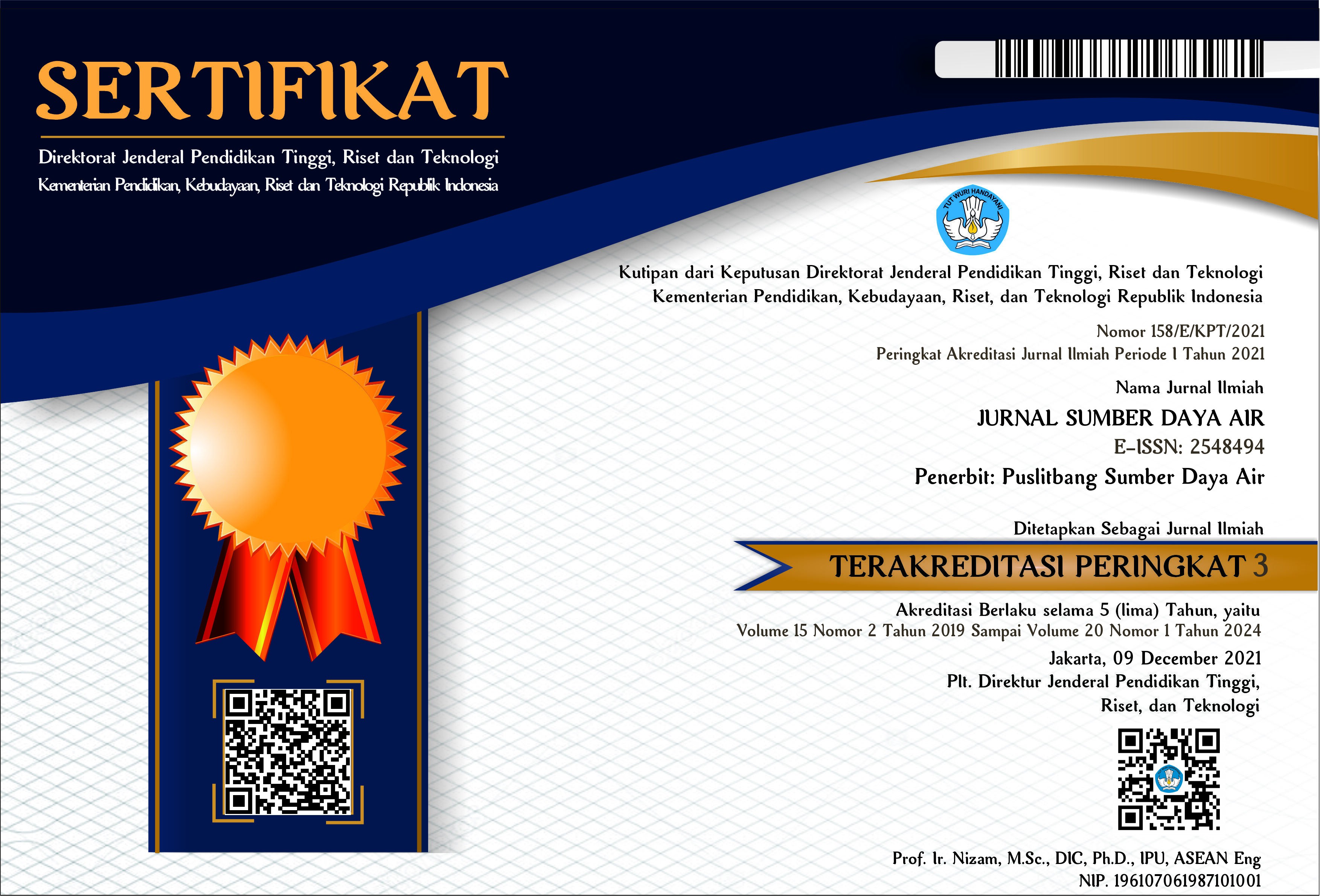KAJIAN LAJU INFILTRASI PADA LERENG YANG TERTUTUP ABU VULKANIK BERDASARKAN EKSPERIMEN SKALA LABORATORIUM
DOI:
https://doi.org/10.32679/jsda.v18i1.744Abstract
Indonesia has 129 active volcanoes; therefore, the volcanic-related disasters risk is relatively high. Lahar flood is a secondary post-eruption disaster, which is triggered by the rainfall due to the movement of volcanic material by the runoff. After the eruption, there will be some significant changes in the watershed characteristics, especially the land cover, slope, and eruption material. This condition increases the possibility of the lahar flood events. Several studies have indicated an increase in runoff due to volcanic ash deposits on slopes. In this regard, the aim of this research is to understand the effects of volcanic ash layer on the slope on the infiltration rate. The physical model laboratory in the form of a laboratory-scale demonstration plot (demplot) were used, where the parameters reviewed include the slope, the volcanic ash thickness, and the rainfall intensity. The results indicate that the infiltration rate on the slopes covered with volcanic ash decreases with the average decrease in the ratio of infiltration to total rainfall about 1.6% per 1 cm thickness of the volcanic ash layer. In addition, the decrease in infiltration rate per 1 cm thickness of volcanic ash on a slope with a slope of 80 was higher (2.3%), compared to a slope of 150 (0.7%). The Philip's infiltration model fits better with the actual measurement data than the Green-Ampt one. The significant parameter in influencing the infiltration rate of the volcanic ash layer with Philip's model based on sensitivity analysis is sorptivity.
Keywords: Infiltration rate, Philip, Green-Ampt, volcanic ash, physical model test.
Â
Abstrak
Indonesia memiliki 129 gunung berapi aktif, sehingga risiko bencana terkait gunung berapi tinggi. Banjir lahar merupakan bencana sekunder yang terjadi pasca erupsi gunung berapi yang dipicu oleh hujan akibat material erupsi terbawa oleh aliran hujan ke hilir. Pasca erupsi, terjadi perubahan karakteristik Daerah Aliran Sungai (DAS) yang cenderung signifikan, terutama pada tutupan lahan, kemiringan lereng dan material erupsi. Hal ini mengakibatkan peningkatan kemungkinan terjadinya banjir lahar. Beberapa penelitian mengindikasikan peningkatan limpasan permukaan (runoff) akibat terhambatnya infiltrasi oleh endapan abu vulkanik pada lereng. Dengan memperhatikan hal-hal tersebut, maka tujuan penelitian ini adalah untuk mengetahui pengaruh lapisan abu vulkanik pada lereng terhadap laju infiltrasi. Penelitian ini menggunakan pendekatan eksperimental uji model hidraulik (UMH) berupa demonstration plot (demplot) skala laboratorium, dimana parameter yang ditinjau meliputi kemiringan lereng, ketebalan abu vulkanik serta intensitas hujan. Dari penelitian ini diperoleh laju infiltrasi pada lereng yang tertutup abu vulkanik menurun oleh ketebalan lapisan abu vulkanik dengan rata-rata penurunan rasio infiltrasi terhadap total hujan sekitar 1,6% per 1 cm ketebalan abu vulkanik. Selain itu, penurunan laju infiltrasi per 1 cm ketebalan abu vulkanik pada lereng dengan kemiringan 80 lebih tinggi (2,3%), dibandingkan lereng 150 (0,7%). Model infiltrasi Philip memberikan hasil yang lebih mendekati data pengukuran aktual dibandingkan model infiltrasi Green-Ampt. Parameter yang signifikan dalam mempengaruhi laju infiltrasi pada lapisan abu vulkanik dengan model Philip berdasarkan analisis sensitivitas adalah sorptivitas.
Kata Kunci: Laju infiltrasi, Philip, Green-Ampt, abu vulkanik, uji model fisik.Downloads
Published
How to Cite
Issue
Section
License
The Authors submitting a manuscript do so on the understanding that if accepted for publication, copyright of the article shall be assigned to Jurnal Sumber Daya Air and Pusat Penelitian dan Pengembangan Sumber Daya Air as publisher of the journal.Copyright encompasses exclusive rights to reproduce and deliver the article in all form and media, including reprints, photographs, microfilms and any other similar reproductions, as well as translations. The reproduction of any part of this journal, its storage in databases and its transmission by any form or media, such as electronic, electrostatic and mechanical copies, photocopies, recordings, magnetic media, etc. , will be allowed only with a written permission from Jurnal Sumber Daya Air and Pusat Penelitian dan Pengembangan Sumber Daya Air.
Jurnal Sumber Daya Air and Pusat Penelitian dan Pengembangan Sumber Daya Air, the Editors and the Advisory International Editorial Board make every effort to ensure that no wrong or misleading data, opinions or statements be published in the journal.




















